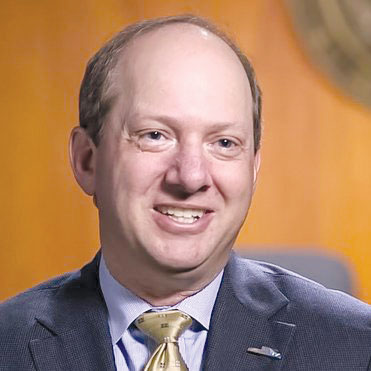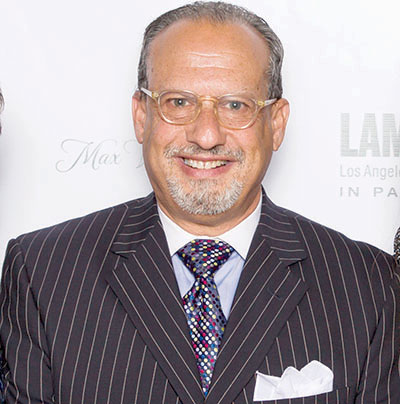
A week before Rosh Hashanah, philanthropist and world-renowned litigator E. Randol Schoenberg shocked the Los Angeles community when he announced on Facebook that he was withdrawing his support from the Los Angeles Museum of the Holocaust in Pan Pacific Park (LAMOTH), an institution he has supported since 1996 and which he helped transform into a leading Holocaust education destination.
In a Sept. 14 Facebook post, Schoenberg, a former president of the museum, signaled that his decision was the result of friction with the institution’s current leadership.
“I am sad to say I have decided I can no longer support the new management of Los Angeles Museum of the Holocaust and therefore cannot continue to be involved with or support the museum,” Schoenberg wrote. “Thank you to everyone who has supported the museum during the 21 years I have been there. I am very proud of what we accomplished together.”
Within minutes, dozens of comments piled up on Schoenberg’s Facebook page expressing shock and confusion over what had gone wrong at the institution where he once played such an integral role.
“The obvious question is why you made this decision,” one woman wrote. “Not lightly, I’m sure. And to announce this so publicly on Facebook adds extra weight to your words. … Please don’t drop this bombshell without explaining it. Not fair to your legion of fans or the museum.”
But Schoenberg provided no further explanation on social media.
In an interview with the Journal, Schoenberg denied that he simply is having a hard time allowing the new leadership to take charge and suggested something more dysfunctional than change is poisoning the atmosphere at one of the city’s most prized Jewish institutions.
“The last month has been very difficult for me,” Schoenberg said. “Change is always difficult. But that isn’t what this was about.”
Schoenberg declined to get into the details but indicated that the last year has been full of friction.
When reached for comment, LAMOTH President and CEO Paul Nussbaum said he was “personally saddened” by Schoenberg’s decision.
“Randy was the one who recruited me to come onto the board of directors, so there’s a personal loss to me,” said Nussbaum, a former banking and wealth management executive. “I had looked to Randy for institutional knowledge and support, counsel and advice early on.”

Schoenberg’s decision to distance himself from the very leadership he helped install left many wondering how a relationship that began in mutual respect and trust had soured.
“Change is traumatic, and sometimes change is most traumatic for people who are founders or significant contributors to the development of an enterprise,” Nussbaum said.
By the time Shabbat arrived on Sept. 15, Schoenberg’s name had been scrubbed from the LAMOTH website’s list of honorary directors. Next, the museum issued a statement from the Goldrich Family Foundation — the museum’s other major benefactor — affirming support for the leadership that Schoenberg couldn’t tolerate.
“The Goldrich family and the Goldrich Family Foundation strongly support the current management team at the Museum and have been in active consultation with the management team as it has implemented changes over the last few years to support the Museum’s growth and continued vitality,” the statement said.
For years, Schoenberg and Jona Goldrich, a real estate developer and Holocaust survivor who died last year at 88, worked together as the most significant and passionate supporters of the museum. He also was one of the lead donors for the museum’s permanent building in Pan Pacific Park.
One of his daughters, Andrea Goldrich Cayton, now serves as LAMOTH vice president.
Goldrich’s other daughter, Melinda Goldrich, who is a museum board member, wrote to the Journal, “Both my sister and I feel that the museum, through its current staff and supportive board members, has come a long way from its early days of inception. Though it is a young museum in its current form, its evolution is ongoing and as the primary donors to the operation, we couldn’t be more pleased to see these changes.”
Schoenberg first joined the LAMOTH board in 1996, nearly a decade before he won a landmark art-heist lawsuit that made him an international celebrity. With the case, Republic of Austria v. Altmann, Schoenberg restored a group of Gustav Klimt paintings stolen by the Nazis to their rightful Jewish owner, Maria Altmann.
The case was popularized by the 2015 film “Woman in Gold,” starring Helen Mirren as Altmann and Ryan Reynolds as Schoenberg. In 2005, the lawsuit reached the United States Supreme Court, and by early 2006 Austria agreed to remove the paintings from the country’s museums and turn them over to Altmann.
After the five Klimt paintings were recovered and sold at auction for an estimated $327 million, Schoenberg, who reportedly received 40 percent of the proceeds, became a wealthy man. In addition to the leadership role he assumed in December 2005 as president of LAMOTH, which was founded by a group of Holocaust survivors in 1961, he also was in a position to help fund the expansion and operation of the museum.
During the decade he served as LAMOTH president, Schoenberg led a $20 million capital campaign to expand the museum into an eco-friendly, state-of-the-art building in Pan Pacific Park. It opened its doors in 2010, at a ceremony attended by city officials and Jewish community leaders.
In addition to fundraising, Schoenberg was meticulous in overseeing the new building’s details, including designing its permanent exhibitions, curating its award-winning audio guides and dreaming up the centerpiece exhibition, “Tree of Testimony,” a data-visualization art project featuring 52,000 survivor testimonies.
Since 2006, Schoenberg, who is guarantor for the museum’s line of credit, has contributed about $7.7 million to the museum, he said.
But last summer a reshuffling of museum leadership led to some unexpected changes, triggering a turbulent series of events.
In August 2016, the museum’s then-executive director, Samara Hutman, whom Schoenberg supported, began an abrupt and unexplained leave of absence. As word quietly spread among the L.A. Jewish community, many were surprised that a woman who had served the museum for three years and was credited with improving its programming and raising its public profile disappeared from her desk.
Around that same time, Nussbaum, who previously had served as board treasurer, took over as president and former president Beth Kean assumed the position of executive director.
Three months passed before a formal announcement was made on the museum’s website, explaining that Hutman was leaving the museum and returning to the Remember Us organization, a Holocaust engagement program for teens.
When reached by phone, Hutman declined to comment on the reasons for her departure. So did Schoenberg. Nussbaum also declined to comment, citing pending litigation.
Once Nussbaum and Kean took over the management of LAMOTH, they initiated changes that affected the operation of the organization and its staff. Schoenberg played a periodic role, stepping in on an as-needed basis — sometimes by request and sometimes through personal initiative. Eventually, conflict arose about the way museum business was handled.
In interviews, Schoenberg insisted he offered a helping hand for the health of the museum. Nussbaum defended the new ways.
“The museum is in incredible shape,” Nussbaum said. “It is thriving. We’re in the greatest fiscal health that this organization has ever been in, and our programs and our galleries are teaching tens of thousands per year about the Holocaust. This year, we’ll have 20 percent more visitors than we had the year before.”
He added, “That should put your questions in context.”
When asked if Schoenberg’s departure was related to a personality conflict, Nussbaum responded: “I’m not going to enter into that discussion.”
He also declined to be specific about how the loss of Schoenberg’s financial contributions would impact the museum.
“At this point, if you’re talking only about financial support, we are not facing the loss of a significant supporter on a yearly basis,” Nussbaum said. “This is about change. All it’s about is about change.”
Schoenberg rejected the notion that he was having a hard time letting go, explaining that he always had planned to step out of the way and hand the reins to a successor.
“This was a very tough decision for me to make,” he said. “Obviously, I’ve put a lot into the museum and I’m very proud of what we accomplished because it was a team effort. Unfortunately, many members of that team are no longer there.”
Asked what he’ll do next, Schoenberg said he is about to publish a book of correspondence between his grandfather, composer Arnold Schoenberg, and writer Thomas Mann. Titled, “The Doctor Faustus Dossier,” it reveals the dispute between Mann and Arnold Schoenberg after Mann used the composer as the model for the title character of his novel “Doctor Faustus” — a character who sells his soul to the devil.
Schoenberg also is devoted to the study of Jewish genealogy and continues to advocate for the restoration of Nazi-looted art to its lawful owners.
“I always keep busy,” he said. “I’m not gonna be twiddling my thumbs.”





















 More news and opinions than at a Shabbat dinner, right in your inbox.
More news and opinions than at a Shabbat dinner, right in your inbox.